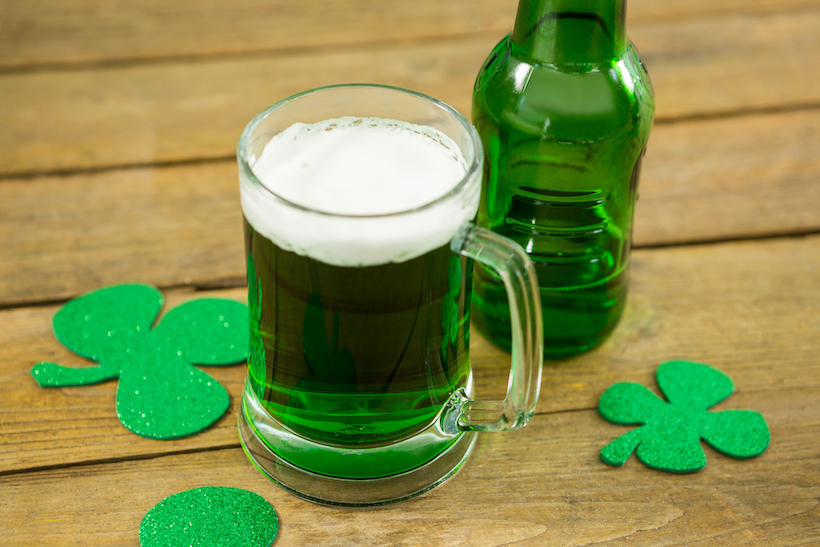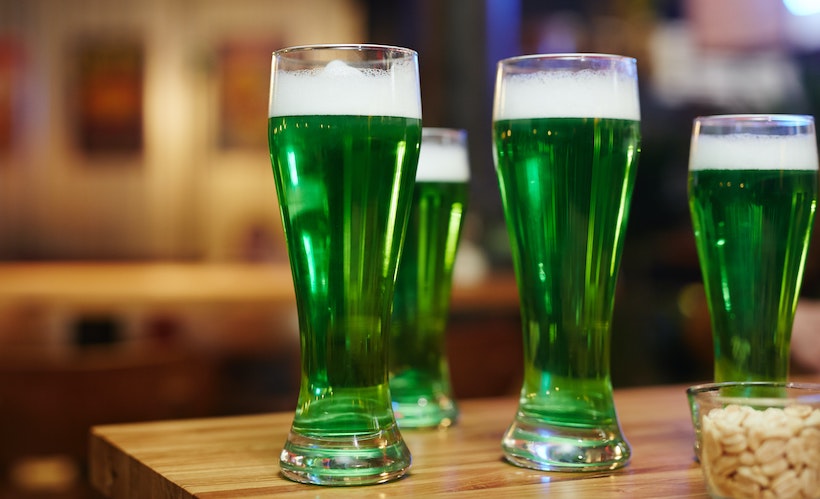Modern St. Patrick's Day is an inspiring day of green: clothes, face paints, decorations, food, and, yes, beer.
Raising a green glass to the Irish has long been a fun American tradition on March 17, the day internationally known as St. Patrick's Day. Let's take a closer look at how that happened and explore some of the history of green beer on St. Patrick's Day.

Green beer is exactly what it sounds like: regular beer dyed green for St. Patrick's Day. Bars and festivals all over the United States and beyond serve this concoction on March 17 (and into the morning hours of the 18th!).
Interestingly, "green beer" once meant – well, still means – something less literal and fun: beer that isn't ready to be consumed. Beer that's too young contains high levels of an organic compound called acetaldehyde, a natural byproduct of fermentation that usually clears up before its completion.
A young beer high in acetaldehyde will taste sour like green apples, hence the term "green beer."
It's quite easy being green when it comes to beer: adding a mere three to five drops of green food coloring per pint of beer is enough to give it a hue worthy of the holiday. To ensure even color, the bartender adds coloring to a glass before pouring beer.
Some people suggest adding blue food coloring to a yellow-hued beer – but unfortunately, that usually produces a turquoise beer instead. For the most vibrant, festive color, it's best to stick with pure green food dye.
Typically, the food coloring in green beer is a synthetic dye called Fast Green FCF. The European Union has banned its use in food over concerns about its carcinogenic potential, but you shouldn't necessarily be alarmed.
We consume food dyes in our diet often—and you probably don't ingest green dye very often outside of St. Patrick's Day—so a green beer or two (or even three) is highly unlikely to cause you serious harm. If anything, you might have a bit of a rough digestion day the next day, as dyes don't tend to absorb well.
But that's a small price to pay for a festive night of revelry, right?
As Ireland's most iconic beer, Guinness is typically the star of the show on St. Patrick's Day. But because Guinness is a particularly dark, creamy stout, you may also see lighter-colored beers dyed green such as a pilsner or pale ale. Generally, a lighter beer will make it easier to attain a brighter green.
Lent is the 40-day period of the Catholic liturgical year featuring prayer, self-control, fasting, and charity that runs from Ash Wednesday to sundown on Holy Thursday. During this time, adherents do penance in preparation for the Lord's resurrection on Easter Sunday. Typically, Catholics fast (or at least avoid dairy and heavier meats) and avoid vices such as drinking.
However, because St. Patrick's Day always falls during Lent, dioceses often lift Lenten restrictions on St. Patrick's Day so that people can celebrate.

This may come as a shocker, but Ireland's patron saint wasn't born there. Instead, his homeland of Great Britain was part of the Roman Empire throughout his lifetime in the fifth century. Irish pirates captured and enslaved Saint Patrick at age 16 until he stowed away on a ship and escaped six years later.
Upon his return to Britain, Saint Patrick became a cleric and eventually a bishop. One day, he reportedly had a vision of the then-polytheistic Irish people calling out to him, "We appeal to you, holy servant boy, to come and walk among us." This vision inspired him to return to Ireland as a Christian missionary.
According to legend, Saint Patrick drove all the snakes out of Ireland during his stay. However, the frigid waters surrounding the island nation would've made it impossible for snakes even to reach Ireland in the first place. Because serpents often symbolize evil in the Christian faith, the myth most likely serves as an allegory for paganism's expulsion.
Long after his death on March 17, 461 A.D., Saint Patrick's impact on the now-heavily Catholic nation remains profound. According to Ireland's most recent census in 2016, 78.3 percent of the population identifies as Catholic. And although St. Patrick technically was never Canonized as a Saint (although he is listed as one!) and wasn't Irish, he's still the patron Saint of Ireland.
At first, a solemn commemoration of Saint Patrick's death primarily through church services, St. Patrick's namesake holiday gradually evolved into a grand feast celebrating his life. During the party, celebrants temporarily paused Lenten food and alcohol restrictions, which led to drinking's association with the holiday.
Over time, St. Patrick's Day became less about the man and more about Irish culture in general, especially as Irish Americans embraced it. During the 1840s, the thousands of people who immigrated to the U.S. to escape the Irish Potato Famine began holding huge St. Patrick's Day parades to celebrate being Irish.
Ever since, Americans took the holiday and ran with it, transforming St. Patrick's Day into the joyous occasion it is today. Nowadays, the holiday is filled with festivals, parades, and general merriment – along with other Irish and Irish-adjacent foods such as corned beef, colcannon, and soda bread.
Before you pinch someone for not wearing green this St. Patrick's Day, remember that blue was the color initially attributed to St. Patrick.
However, green overtook blue during the 1600s when people began wearing shamrocks during the holiday. Legend has it that St. Patrick used the three-leaf clover (☘️) to explain Christianity's Holy Trinity of the Father, the Son, and the Holy Spirit.
The much rarer four-leaf clover (🍀), on the other hand, symbolizes the luck of the Irish, a concept that came about during the gold rush of the mid-to-late 1800s when many Irish and Irish American miners struck it rich.
Furthermore, the color green carries important political significance for Ireland. During the conflict between the Irish and the English, green represented the Irish Catholics while the English Protestants donned orange.
Of course, green and orange still coexist on Ireland's flag today, with a stripe of white between them to symbolize peace – but on St. Patrick's Day, you'll see far more green than orange in the form of clothing, ribbons, and anything else you can wear on your person.
In 1914, an Irish American coroner named Dr. Thomas Hayes Curtin unveiled his green brew at the Schnorrer Club in the Bronx, New York City. Curtin used a drop of wash blue to dye the beer green—a poisonous laundry whitener made from iron powder. (Much riskier than today's green dyes!)
However, Curtin may not have been green beer's original inventor. Four years earlier, The Spokane Press reported that the First Avenue Bar served green beer on March 17, but the bartender refused to divulge how he made it.
Slowly but surely, green beer caught on around the United States as more and more Irish Americans helped popularize St. Patrick's Day. The number of Americans who claim Irish ancestry is 6.5 times the entire population of Ireland.

Every year on St. Patrick's Day, Guinness sales spike by a whopping 819 percent for a total of 13 million pints served. Americans make up a large portion of these sales. St. Patrick's Day ranks as the fourth most popular drinking day in the United States.
The first St. Patrick's Day parade unfolded in an unlikely place: the Spanish Colony of Florida in 1601. Because the colony's vicar, Ricardo Artur, was Irish, he organized a modest procession in what is now the city of St. Augustine.
More than 100 years later, homesick Irishmen serving in the British military marched in St. Patrick's honor first in 1737 in Boston and then in 1762 in New York City.
Since then, the New York City Parade has become the largest globally, with 150,000 politicians, bands, first responders, and school children marching 1.5 miles up Fifth Avenue while drunken revelers spill out of nearby bars to watch.
In addition to simply wearing the color on St. Patrick's Day, some people aim to turn everything around them green for the festivities.
In 1961, the citizens of Savannah, GA, tried to dye the Savannah River green for St. Patrick's Day... but failed because the river flowed too quickly. A year later, Chicagoans borrowed the idea and pulled it off. Today, the Windy City dumps 50 pounds of green vegetable dye into the Chicago River on St. Patrick's Day to give it a bright green hue.
The green river tradition even made its way to the White House when the Obamas—who hail from Chicago—took office in 2009. But instead of messing with the Potomac, they dyed the White House fountains' water green, bringing the celebration of the Irish into the nation's capital.
Whether you partake in the drinking or not, the tradition of green beer – and everything else green – is a fun one. For believers, St. Patrick's Day is a brief break from a time of contemplation and fasting... and a whole lot of fun. For everyone else, it's – well – also a whole lot of fun.
Whichever side of that divide you find yourself on, I hope you have a great St. Patrick's Day!